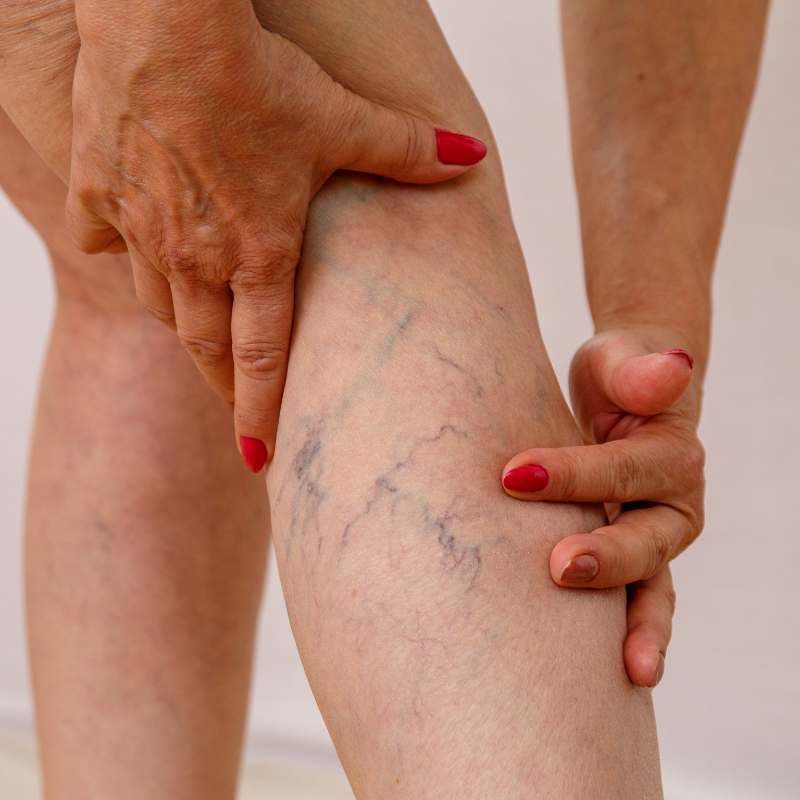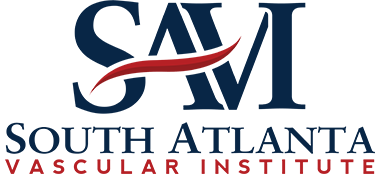LET'S TALK ABOUT
VARICOSE VEINS
Varicose veins affect more than 40 million people in the United States, according to the American Vein & Lymphatic Society. Believed to affect up to 35% of the U.S. population, varicose veins can occur in nearly anyone.
Do you have any of the following symptoms?
Achy or heavy feeling in your legs
Cramping or swelling in your legs
Veins that appear to be bulging or twisted
Increased pain in legs after sitting or standing



ARE YOU TIRED OF DEALING WITH VARICOSE VEINS?
We know you are! Don’t let your varicose veins stop you from enjoying life and doing what you love. At South Atlanta Vascular Institute, we specialize in using the most advanced, least invasive, treatment options for varicose veins. Our team is here to listen to your needs and help you restore your quality of life.
What are Varicose Veins?
Any vein that is near the skin’s surface can become varicosed. Varicose veins are typically something that can be self-diagnosed, as they have a distinct appearance as enlarged, twisted, bulging, blue or dark purple veins. Varicose veins typically form on the legs, due to pressure that is commonly placed on the lower body. Over time the valves located in the legs become weaker and are not able to push blood to the heart as efficiently. This causes blood to flow back into the veins, where pressure builds and the vein becomes enlarged. The surrounding tissue near varicose veins may also swell, itch, emit a burning sensation or radiate pain, as fluid leaks from the vein and begins to pool.
Who Is At Risk?
Anyone can fall victim to varicose veins. However, certain factors may increase the likelihood of varicose veins developing. Age, gender, obesity, heredity, pregnancy, hormone changes and sedentary activity level could contribute to varicose veins. Varicose veins tend to occur more for older individuals, as aging places wear and tear on the valves that control blood flow within the veins. Women are also more likely to experience varicose veins due to hormonal fluctuations surrounding menstruation, pregnancy and menopause. Family history of varicose veins is another significant risk factor. If one of your parents has varicose veins, you have a 40 percent chance of developing them, and if both parents have varicose veins, your risk climbs to 90 percent. While these factors are out of your control, there are several lifestyle factors that also contribute to varicose veins. Obesity and sedentary activity levels encourage the formation of varicose veins. Being overweight adds extra pressure on the veins, whereas sitting for lengthy periods of time discourages blood flow, potentially leading to varicose veins.
If you suffer from varicose veins, you’re likely familiar with the uncomfortable symptoms involved. Varicose vein symptoms include pain, heaviness, cramping, itching, swelling and burning. However, some individuals with varicose veins may not experience pain at all. While varicose veins are merely a cosmetic issue for some, many experience pain and discomfort. If symptoms include pain or worsen over time, you should discuss treatment options with a vein specialist.
THE ANSWER YOU HAVE BEEN WAITING FOR...
WHY SHOULD I CHOOSE SAVI?
MULTI-SPECIALTY PRACTICE – Our practice consists of both vascular interventionalists and vascular surgeons to allow us to completely treat our patients when it comes to vascular care.
OUTPATIENT SURGERY CENTER – Our facility is equipped with an outpatient surgery center that allows us to perform minimally invasive procedures in office.
ACR ACCREDITED ULTRASOUND FACILITY – We are proud to say that our office is an accredited ultrasound facility through the American College of Radiology
OUR #SAVISTAFF – From the time you walk in the door to the time you leave, our team is dedicated to making your experience here the absolute best.
How to Treat Varicose Veins?
There are a variety of varicose vein treatment options available based on the severity of the condition. Self-care measures and at-home treatments may aid in decreasing discomfort and pain. The use of long compression socks or stockings during the day is one simple approach. Compression garments work by squeezing the legs so blood flows more efficiently. Similarly, exercise, stretches, elevating legs and movement throughout the day and evening may ease symptoms or prevent the condition from becoming worse. In the event that compression and movement do not ease varicose vein symptoms, there are several surgery options and procedures that may help.
At South Atlanta Vascular Institute, we offer a variety of treatment options to address varicose veins. The treatments are generally done in-office, with a short recovery time, fitting into modern patient lifestyles. The latest varicose vein procedures include:
- Sclerotherapy: Varicose veins are injected with a solution that collapses and closes off the vein. Over the course of several weeks, varicose veins will fade. This treatment may need to be repeated, in some cases. Generally, this is a no-downtime procedure that allows patients to resume regular activities immediately.
- Venaseal: The Venaseal closure technique is a method used for treating varicose veins by sealing them with medical adhesive. This process involves closing off the problematic vein with a glue-like substance, causing it to harden and eventually be absorbed by the body.
- Laser Therapy: Bursts of light are directed onto the skin, targeting the varicose vein that lie underneath. This treatment is non-invasive, requiring no needles or cutting.
- Catheter Based Treatment: This procedure is typically used when larger varicose veins are involved. A catheter is placed into an enlarged vein, then heated using laser energy or radiofrequency. The heat destroys the vein by causing it to collapse and seal shut. The closed vein reabsorbs into the body and blood flow is rerouted.
- High Litigation Vein Stripping: This treatment is more involved and my occur as an outpatient procedure. The varicose vein is tied off before joining a deeper vein and removed through a small incision, redirecting blood flow to healthy veins.
- Ambulatory Phlebectomy: Typically used for smaller varicose veins, a series of tiny skin punctures are made to remove the vein entirely. Scarring and down-time are minimal with this approach.
Determining which varicose vein treatment is right for you may seem like a difficult task. That’s why the medical staff at South Atlanta Vascular Institute take the time to assess, diagnose and discuss treatment options specific to each patient’s symptoms and concerns.
Are there risks with varicose veins?
Addressing varicose veins can help prevent associated complications from occurring. Beyond pain and discomfort, it is possible to develop medical conditions related to varicose veins, that include ulcers, blood clots and bleeding. Ulcers may form near varicose veins, if left untreated. Leg ulcers tend to occur near the ankle and begin to present as a discolored spot on the skin. If varicose veins are deep or prominent, blood clots may form. If you experience leg pain or swelling, it could be a sign of a blood clot and will require immediate medical attention. Varicose veins near the skin’s surface may also rupture and cause bleeding. Complications resulting from varicose veins will need to be promptly attended to by a healthcare provider.
The vein specialists at South Atlanta Vascular Institute look forward to addressing all your medical and cosmetic questions and concerns. Contact us today to schedule an appointment to discover more about our advanced, minimally invasive varicose vein treatment options.
